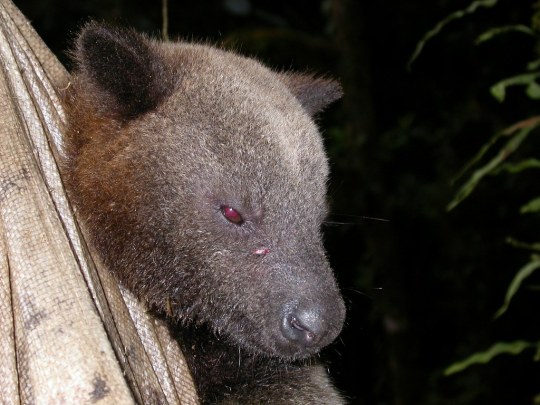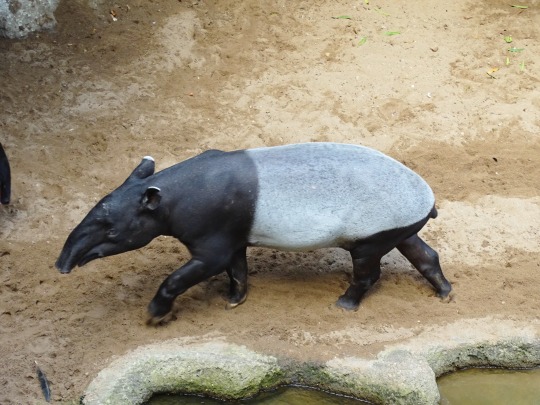#dendrolagus dorianus
Text
Tree Kangaroos and Rufous Bettongs are largely solitary, although they sometimes associate in pairs, trios, or small groups of adults and their young.

"Biological Exuberance: Animal Homosexuality and Natural Diversity" - Bruce Bagemihl
#book quotes#biological exuberance#bruce bagemihl#nonfiction#rufous bettong#rat kangaroo#aepyprymnus rufescens#doria's tree kangaroo#dendrolagus dorianus#matschie's tree kangaroo#dendrolagus matschiei#solitary#pair#trio#small group
0 notes
Photo

Unicolored tree kangaroo (Dendrolagus dorianus)
Photo by John Slapcinsky
#unicolored tree kangaroo#doria's tree kangaroo#tree kangaroo#dendrolagus dorianus#dendrolagus#macropodinae#macropodidae#macropodoidea#macropodiformes#diprodontia#australidelphia#marsupialia#metatheria#mammalia#tetrapoda#vertebrata#chordata
25 notes
·
View notes
Photo










Bronx Zoo, New York City (No. 41)
Matschie's tree-kangaroo (Dendrolagus matschiei), also known as the Huon tree-kangaroo is a tree-kangaroo native to the Huon Peninsula of northeastern New Guinea island, within the nation of Papua New Guinea.
Under the IUCN classification, Matschie's tree-kangaroo is an Endangered species.
The scientific name honours German biologist Paul Matschie.
With a body and head length of 20 to 32 inches (51–81 cm), Matschie's tree-kangaroo are much smaller than Australia's well-known red kangaroo. An adult male weighs between 20 and 25 lb (9–11 kg). An adult female weighs between 15 and 20 lb (7–9 kg)
There is no particular season in which they breed. Gestation lasts 44 days and joeys of captive bred individuals leave the pouch after 11 months. The average life span of the Matschie's tree-kangaroo in the wild is unknown, but is at least 14 years. The life span of the kangaroo in a zoo is about 20 years.
The most distinctive trait of all tree-kangaroos is the hair whorl they possess. It is a patch of hair that goes out in many directions and its location ranges from up near the shoulders all the way down to the tail. The Matschie's tree-kangaroo is golden on its ventral side, lower parts of its limbs, ear edges, belly, and tail, and the rest of its body is a chestnut brown colour, except for usually having a dark stripe down its back. Their faces are typically an array of yellow and white colours. The Matschies’ are similar in colour and size to Dendrolagus dorianus, the Doria's tree-kangaroo. Matschies’ ears are small and bear-like looking and they do not have a good sense of hearing because of it. They have curved claws on their forelimbs and soft pads on their hind limbs that aid in their climbing ability, and they have some independent movement of their digits as well as good dexterity due to their forelimbs being able to bend a great deal. The 4th and 5th digit of their feet are enlarged, the 1st digit is absent, and the 2nd and 3rd digits are syndactylous (two digits that look like one fused together). Scientists have discovered that the Matschie's are able to walk bipedally and there's a lot of rotation in their limbs for climbing. Out of all of the Dendrolagus species, the Matschie's tree-kangaroo is the best vertical climber and has more strength in its muscles than any others. Their tails help to offset their balance while moving swiftly through the trees since their tails are about the same length as their head and body size. Sexual dimorphism is very low, with males and females being of about equal sizes. The upper and lower jaws of the Matschie's tree-kangaroos are different too in addition to them being different in body size. The upper jaw has three incisors, one canine, one premolar, and four molars, while the lower jaw has one very sharp incisor, no canines and low crowned molars.
Source: Wikipedia
#Huon tree-kangaroo#Bronx Zoo#JungleWorld#my favorite zoo#animal#USA#indoors#Total Experience attraction#worth the money#New York City#summer 2018#reptile#sailfin lizard#Malayan tapir#Asian Tapir#landmark#tourist attraction#cityscape#nature#flora#fauna#tree#close up#detail#original photography#Northeastern USA
4 notes
·
View notes
Text
New to science - A new species of Tree Kangaroo, Genus Dendrolagus Müller, 1840 from Tembagapura, Mimika, Irian Jaya, Indonesia.
Hoser, R. T. 2019. A new species of Tree Kangaroo, Genus Dendrolagus Müller,
1840 from Tembagapura, Mimika, Irian Jaya, Indonesia.
Australasian Journal of Herpetology 40:50-55.
Published 10 July 2019.
LSID urn:lsid:zoobank.org:pub:80A052AC-4B41-455D-93BF-40C5C0BD6F35
ABSTRACT
An ongoing audit of vertebrate fauna in Australasia has revealed an unnamed species of Tree Kangaroo
Dendrolagus Müller, 1840 from Tembagapura, Mimika, Irian Jaya, Indonesia. The purpose of this paper is to
formally name the taxon.
D. hoserae sp. nov. is not common and due to its specialized habitat requirements including relatively cold,
high altitude habitat of limited land area, it is particularly vulnerable to extinction due to an ongoing increase in
human population and activity in the area. Less immediate threats such as global warming, introduced
competing species and pathogens may also cause the ultimate extinction of this little-known taxon.
A subspecies of D. ursinus (Temminck, 1836) is also formally named for the first time.
Keywords: taxonomy; nomenclature; tree kangaroo; Irian Jaya; New Guinea; Indonesia; Dendrolagus;
dorianus; stellarum; mayri; ursinus; new species; hoserae; new subspecies; arfakensis.
Full text available as open access at:
http://www.smuggled.com/issue-40-pages-50-55.pdf
0 notes
Photo

Doria’s tree-kangaroo (Dendrolagus dorianus)
Photo by Miriam Silverstein
#captive animal#doria's tree kangaroo#unicolored tree kangaroo#tree kangaroo#dendrolagus dorianus#dendrolagus#macropodinae#macropodidae#macropodoidea#macropodiformes#diprodontia#australidelphia#marsupialia#metatheria#mammalia#tetrapoda#vertebrata#chordata
11 notes
·
View notes
Photo

Doria’s tree-kangaroo (Dendrolagus dorianus)
Art by Peter Schouten
#doria's tree kangaroo#unicolored tree kangaroo#tree kangaroo#dendrolagus dorianus#dendrolagus#macropodinae#macropodidae#macropodoidea#macropodiformes#diprodontia#australidelphia#marsupialia#metatheria#mammalia#tetrapoda#vertebrata#chordata
5 notes
·
View notes
Photo



Doria’s tree-kangaroo (Dendrolagus dorianus)
Also known as: Unicolored Tree Kangaroo
Doria’s tree-kangaroo is one of the largest tree-kangaroo species, and weighs 6.5–14.5 kg, its length is 51–78 cm, with a long 44–66 cm tail. It has long dense brown fur with black ears and a pale brown or cream nonprehensile tail. This marsupial is found only in montane forests of southeastern New Guinea island. The species was named in 1883 by Edward Pierson Ramsay in honour of Italian zoologist Giacomo Doria. Its diet consists of various leaves, buds, flowers and fruits. The gestation period is about 30 days, after which, the single young remains in the mother’s pouch for up to 10 months. Its forest habitat is threatened by logging and forest clearance. Being large sized, it’s also hunted for its meat.
Classification:
Animalia - Chordata - Mammalia - Metatheria - Marsupialia - Australidelphia - Diprotodontia - Macropodiformes - Macropodoidea - Macropodidae - Macropodinae - Dendrolagus - D. dorianus
Images: [x] [x] [x]
Source: [x]
#doria's tree kangaroo#unicolored tree kangaroo#tree kangaroo#dendrolagus dorianus#dendrolagus#macropodinae#macropodidae#macropodoidea#macropodiformes#diprodontia#australidelphia#marsupialia#metatheria#species feature#mammalia#tetrapoda#vertebrata#chordata
2 notes
·
View notes